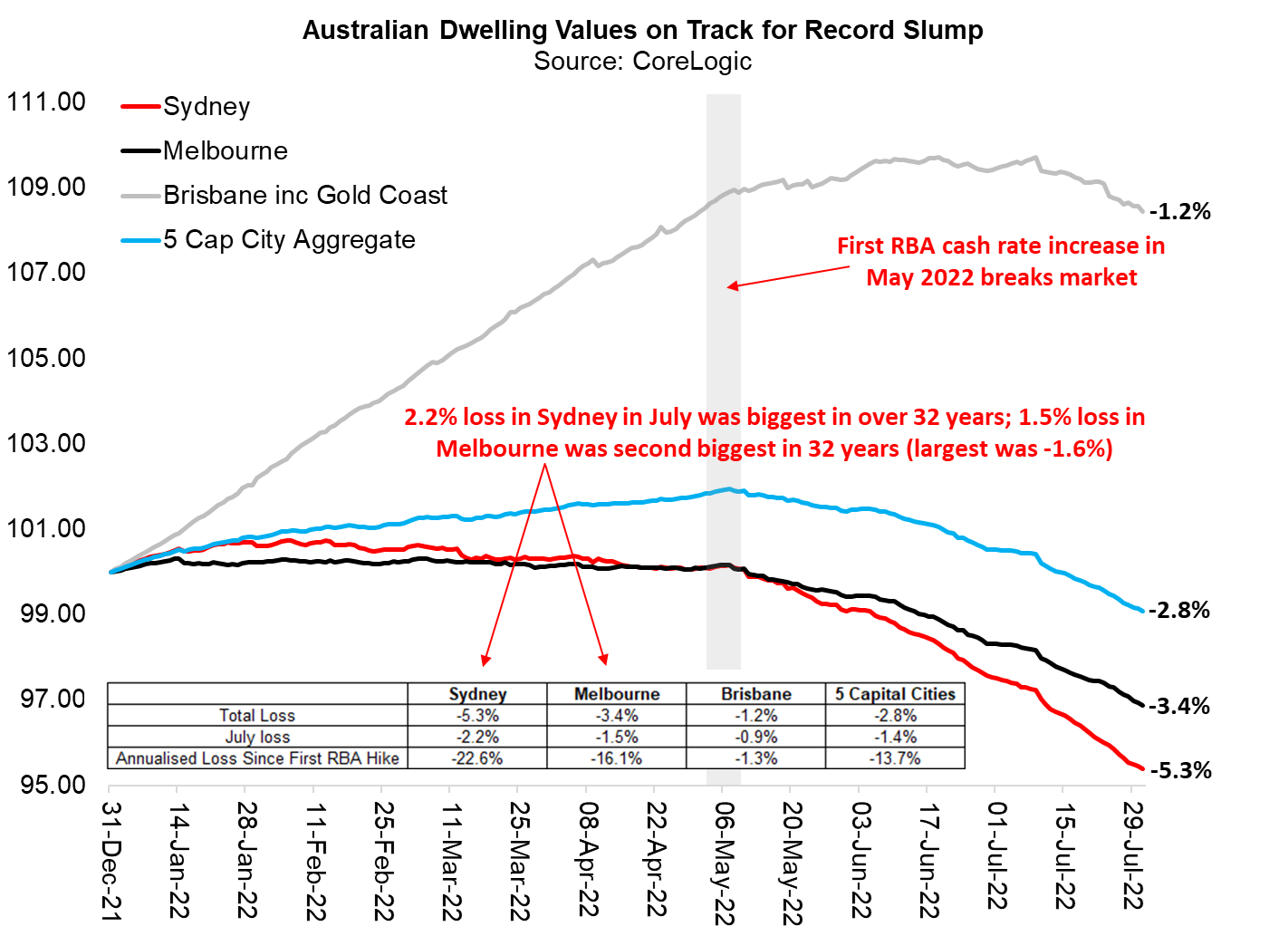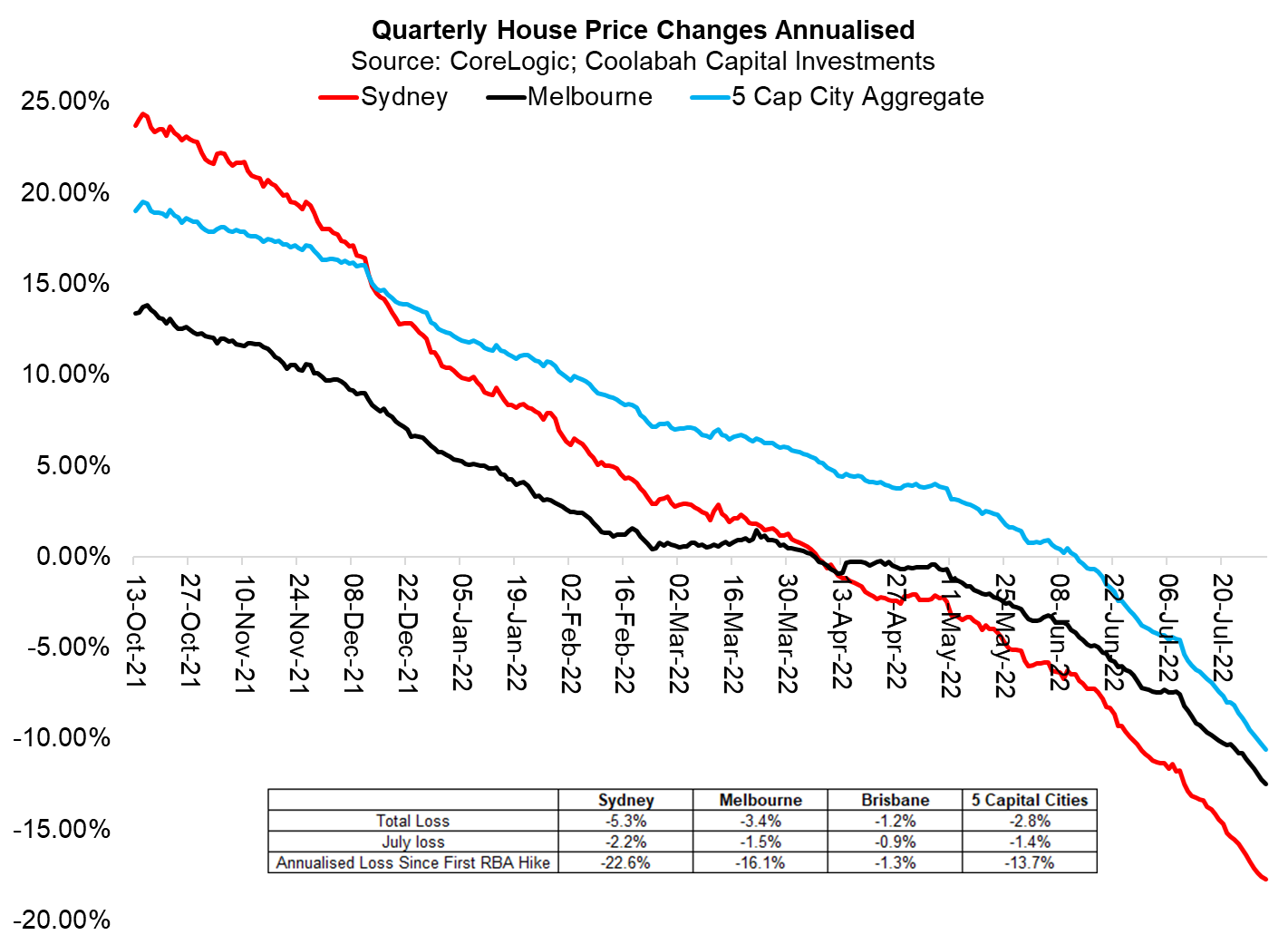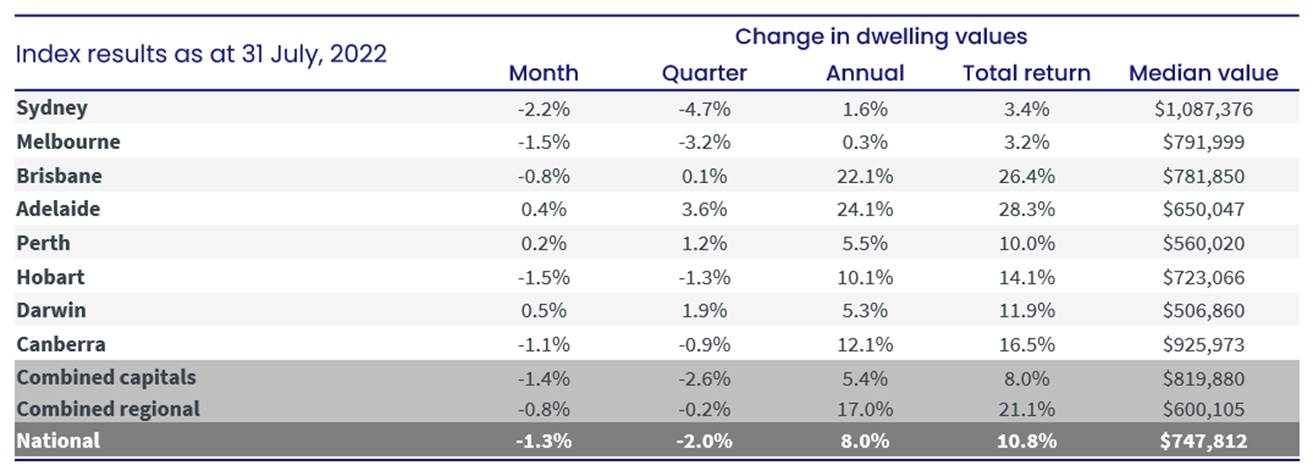Sydney house prices fall at their fastest pace in more than 32 years
The final July 2022 house price index results are now available for analysis from CoreLogic, and they confirm Australia is experiencing what will likely become a record housing crash. In Sydney, dwelling values declined by a staggering 2.2% in the month alone, which was the single biggest monthly loss since January 1990 (the previous record was a 1.8% loss). The story was similar in Melbourne where dwelling values tanked 1.5% in the month of July, just 0.1% off the all-time record since 1990, which was a 1.6% decline. As we had been forecasting for some time, Brisbane home values have also started rolling over hard, dropping a hefty 0.9% in July. Since October 2021, we have forecast a record 15-25% decline in national prices after the first 100 basis points of RBA rate hikes.
Total cumulative losses in Sydney and Melbourne now exceed 5.3% and 3.4%, respectively, since their peak earlier in 2022 (see first chart). While the Brisbane market only started falling a month ago, losses have already cumulated to 1.2%. CoreLogic's 5 capital city index is now down a total of almost 3% with the pace of these losses clearly accelerating (see second chart). We don't have any data on Canberra as of yet, but it will be tracking the Sydney and Melbourne markets. It will also be fascinating to see what CoreLogic tells us about Australia's non-metro or regional markets, which on the east coast are likely to be experiencing similar declines to the larger cities.
As the first chart below shows, the catalyst for the great Aussie housing crash was the RBA hiking rates in May 2022, which triggered a clear structural breakdown (observe how all markets' growth rates change quite sharply after the grey shaded line). The RBA is expected to hike rates in August by another 50 basis points with some forecasters even predicting a 75 basis point increase despite consumer confidence in Australia slumping to GFC-like levels. If the RBA does hike by 50 basis points, borrowers will have had to wear an unprecedented 175 basis points of hikes in the space of circa three months (or since early May).


It is important to remember that the city-wide results cover millions of homes: individual suburbs will be recording much larger or smaller losses depending on their circumstances. This is why we often hear agents say, "Price falls are much larger in my postcodes". Property price movements in individual suburbs often vary markedly from the extremely well diversified city-wide index numbers simply because of the idiosyncratic conditions that impact those localities.
The two notable hold-outs nationally are Adelaide and Perth, which managed to capture small capital gains of 0.4% and 0.2% in July, respectively. It is reasonable to assume that at some point these markets will give up the ghost, or at the very least stop realising price appreciation.
I’m personally long a lot of housing, so I don’t love the fact that there will be a record correction in prices. But our mission is to tell you what we think will happen, irrespective of whether it is convenient to do so...
UPDATE:
CoreLogic's Tim Lawless comments in a media release this morning on the big Sydney bust:
“Although the housing market is only three months into a decline, the national Home Value Index shows that the rate of decline is comparable with the onset of the global financial crisis (GFC) in 2008, and the sharp downswing of the early 1980s. In Sydney, where the downturn has been particularly accelerated, we are seeing the sharpest value falls in almost 40 years.
And CoreLogic confirms that regional (ie, non-metro) Australian markets are now rolling over:
Regional markets have also weakened, with the combined regionals index recording the first monthly decline (-0.8%) since August 2020. Dwelling values were down across Regional New South Wales (-1.1%), Regional Victoria (-0.7%), Regional Queensland (-0.7%) and Regional Tasmania (-0.6%), while values continued to trend higher in Regional SA (1.1%) and Regional WA (0.1%). Overall, regional markets are still outperforming their capital city counterparts, but this month’s figures show major regional centres are not immune to falling home values. “Dwelling values across CoreLogic’s combined regionals index were up 41.1% from the pandemic trough to the June peak, compared with a 25.5% rise across the combined capitals index. The stronger growth reflects a significant demographic shift towards commutable regional markets, which is likely to have some permanency as more workers take advantage of formalised hybrid employment arrangements,” Mr Lawless said. Most of the major regional centres adjacent to Sydney, Melbourne and Brisbane (including Geelong, Ballarat, Illawarra, Newcastle and Lake Macquarie, the Southern Highlands & Shoalhaven, the Gold Coast and Sunshine Coast) recorded a decline in home values over the three months to July, marking the end of nearly two years of significant capital gains.

Our Intellectual Edge: Making Every Basis Point Count
Our edge is in “alpha” generation in liquid, high-grade credit in contrast to traditional fixed-income strategies that drive returns through adding more interest rate duration risk, credit default risk, and/or illiquidity risk (or “beta”). Click here to find out more about us and the products we have available.
1 topic

